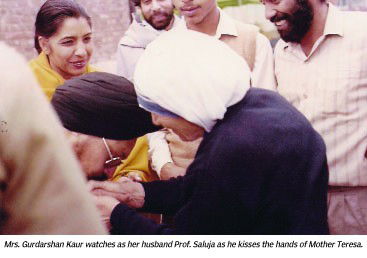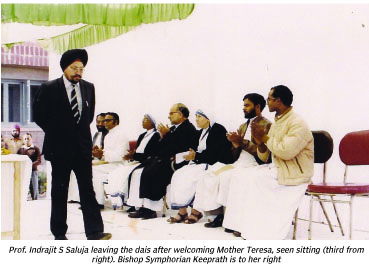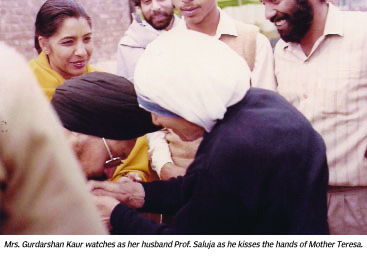Articles features
I touched the tender, soft, loving small hands of a great soul: Prof. Indrajit S Saluja

(Prof. Indrajit S Saluja is now the editor of Indian Panorama, a weekly newspaper in English, published from New York. Read the full article, which was published before the canonization on September 4 in PDF below)
My thoughts go back to January 27th, 1980. Mother
Teresa had come to Ludhiana, Punjab where I was a college lecturer. She had
visited the town to inaugurate Missionaries of Charity's new home in Salem
Tabri neighborhood on Jalandhar Byepass. A few days before she arrived, I
received a call from Father Kurian Muttathupadam who was then Director
Principal of the Sacred Heart Boys School, which was run under the Diocese of
Jalandhar.
Father Kurian told me about Mother Teresa's coming
visit and asked me to welcome her on behalf of the citizens of Ludhiana. I was
overwhelmed with joy at the prospect of getting an opportunity to be in the
gracious company of a wonderful soul. I kept counting the days. I kept
rehearsing my speech which was to be brief.
I was only to extend Mother a welcome and speak
briefly about the noble work she and her organization -Missionaries of Charity
-were doing. Even though I was trained to speak ex tempore on any subject under
the Sun and for long periods, here I was framing, reframing my sentences.
And then on the 27th January, 1980, Mother Teresa
arrived at the venue to inaugurate the new house for Missionaries of Charity and
the inmates which I faintly recall, would have been around 20. And I am told
now there are a hundred inmates who include sisters, destitute women and
children.
It was a huge gathering, mainly of Catholic
Christians who had come not only from Ludhiana but also from neighboring towns
of Phillaur, Phagwara, Jalandhar, Nakodar, Kapurthala, Jagraon, Moga, Khanna,
Chandigarh etc. to catch a glimpse of Mother Teresa.
The Bishop of Diocese of Jalandhar Bishop Symphorian
Keeprath and several priests were present, as was my dear friend Father Kurian
who unfortunately died a year ago. I was invited to speak. In fact, I was the
only person to speak, besides the Bishop and Mother Teresa herself.
After I made a brief speech I came down from the
dais and sat in the front row with my lovely wife Gurdarshan Kaur. The two of
us listened to Mother's message. She spoke of importance of compassion and
love. Her message was simple and clear. God has created all in His own image
and we all are His children.
As such, we must love one another. Later, Mother
went around meeting people. When Gurdarshan and I got our opportunity to be
with her, I held her small, tender hands and kissed them, even as my wife
looked on. I remember Mother uttering blessings and then she moved on.
Little did I know then that Mother Teresa would one
day be a Blessed one, that one day, she will be canonized. I feel so elated to
think that I touched the tender, soft, loving small hands of a great soul. I
feel her presence whenever I think of her. I rejoice in her canonization.
Mother Teresa was widely known as a living saint as
she ministered to the sick and the dying in some of the poorest neighborhoods
in the world. Although some people criticized her for not also challenging the
injustices that kept so many people so poor and abandoned, her simple service
touched the hearts of millions of people of all faiths.
Born to an ethnic Albanian family in Skopje, in what
is now part of Macedonia, she went to India in 1929 as a Sister of Loreto and
became an Indian citizen in 1947. She founded the Missionaries of Charity in
1950. Shortly after she died in 1997, St. John Paul II waived the usual
five-year waiting period and allowed the opening of the process to declare her
sainthood. She was beatified in 2003.
After her beatification, Missionary of Charity
Father Brian Kolodiejchuk, the postulator of her sainthood cause, published a
book of her letters, "Mother Teresa: Come Be My Light." The letters
illustrated how, for decades, she experienced what is described as a "dark
night of the soul" in Christian spirituality; she felt that God had
abandoned her.
While the letters shocked some people, others saw
them as proof of her steadfast faith in God, which was not based on feelings or
signs that he was with her. The date chosen for her canonization is the eve of
the 19th anniversary of her death and the date previously established at the
Vatican for the conclusion of the Year of Mercy pilgrimage of people like her
who are engaged in works of mercy.
Affectionately known as the "saint of the
gutter" for her unconditional love for the poor, abandoned and the
marginalized, she earned several international honors, including the Nobel
Peace Prize in 1979.





































